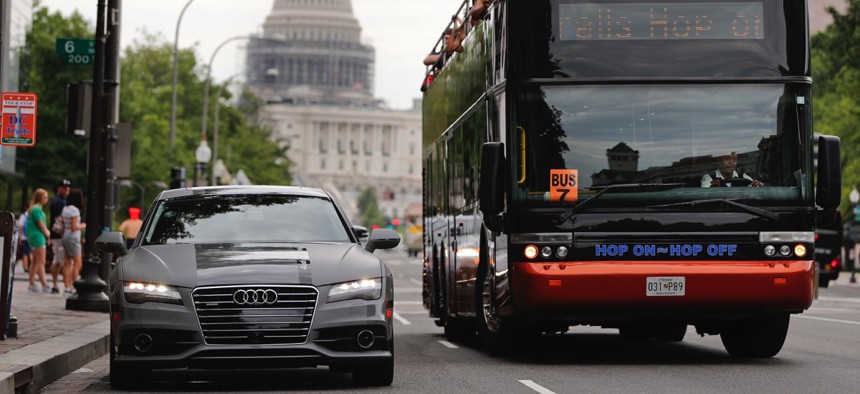Self-Driving Vehicle Backers Push for ‘Federal Framework’

An Audi self-driving vehicle parked on Pennsylvania Avenue near the Capitol in Washington, D.C. Pablo Martinez Monsivais / AP Photo
“If there is no action on this legislation, the result will be delayed testing and deployment in the United States of these life-saving technologies,” said Audi of America’s senior policy strategist.
WASHINGTON — Connected automation has shifted the traffic safety discussion from surviving crashes to avoiding them, but local deployment of self-driving vehicles is hindered by the lack of a national framework for testing and operation, said Alison Pascale, Audi of America senior policy strategist, at a Thursday briefing in the nation’s capital.
Audi is among the automotive manufacturers and infrastructure owners and operators, or IOOs, encouraging the Senate to pass the SELF DRIVE Act, or else the AV START Act, delineating federal and state roles while remaining technology-neutral.
In 2017, 30 states took up 78 proposals attempting to regulate automated driving, creating a patchwork of rules and pilots where jurisdictions are welcoming.
“If there is no action on this legislation, the result will be delayed testing and deployment in the United States of these life-saving technologies,” Pascale said, during the Connected Automation Now panel discussion on Capitol Hill.
Self-driving vehicles could reduce accident frequency as much as 80 percent by 2040, according to consulting firm KPMG.
The National Highway Traffic Safety Administration’s 50-year-old framework need simply be applied to emerging tech, Pascale said.
Colorado looks forward to a national framework but in the interim passed “one of the most progressive laws in the country” permitting self-driving vehicles to operate, so long as they abide by existing traffic laws, said Wes Maurer, director of intelligent transportation systems for the state Department of Transportation.
The District of Columbia’s government launched a pilot project with Audi in March to share data from about 600 traffic signals around the city with its vehicles. The city’s tests are granular, such as looking at how to maximize use of curbside, said Jeff Marootian, D.C. Department of Transportation director.
Audi is one of the first auto manufacturers to install vehicle-to-infrastructure tech in its cars, so they know how much time until a green light, are forewarned of yellows and can time braking at reds. Communication occurs via cellular signal, without needing to go through a cell tower, to quickly alert vehicles of left-hand turn obstructions or intersection hazards—the two most dangerous traffic scenarios.
Audi plans to take advantage of forthcoming fifth-generation, or 5G, wireless communications, and auto manufacturers are adamant the federal government must reserve the proper amount of 5.9 GHz spectrum for that and dedicated short range communications. DSRC is the current industry standard and will use the same band.
“The spectrum is critical to us at this point for taking advantage of these safety benefits,” Maurer said.
Regardless of how data is delivered to the vehicle—DSRC, 5G or some as-yet-undeveloped technology—Transurban, an IOO that develops and manages toll road networks, strives to be tech-agnostic.
Transurban’s sensor-dense roads are getting better at predicting where traffic accidents will occur and keeping construction crews safe. A mobile solution the company uses in control rooms issues an alert when workers stray outside designated safe zones.
Microwave vehicle detectors know how many cars are on the road and their speed of travel at all times, so Transurban can price the road.
“One of the things that we’ve invested in is really trying to build out an ecosystem of capabilities,” said Robert Deans, Transubran’s North America head of technology. “We don’t know what the winners will be in the future.”
Dave Nyczepir is a News Editor at Government Executive’s Route Fifty and is based in Washington, D.C.
NEXT STORY: Columbus unveils 'initial' smart city operating system






